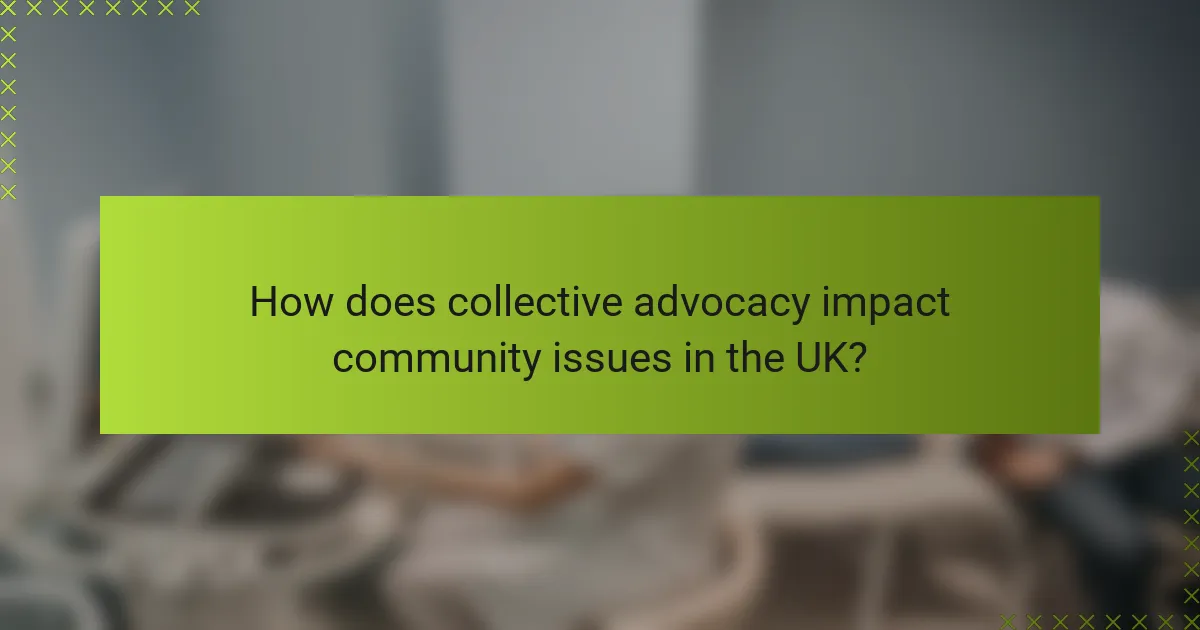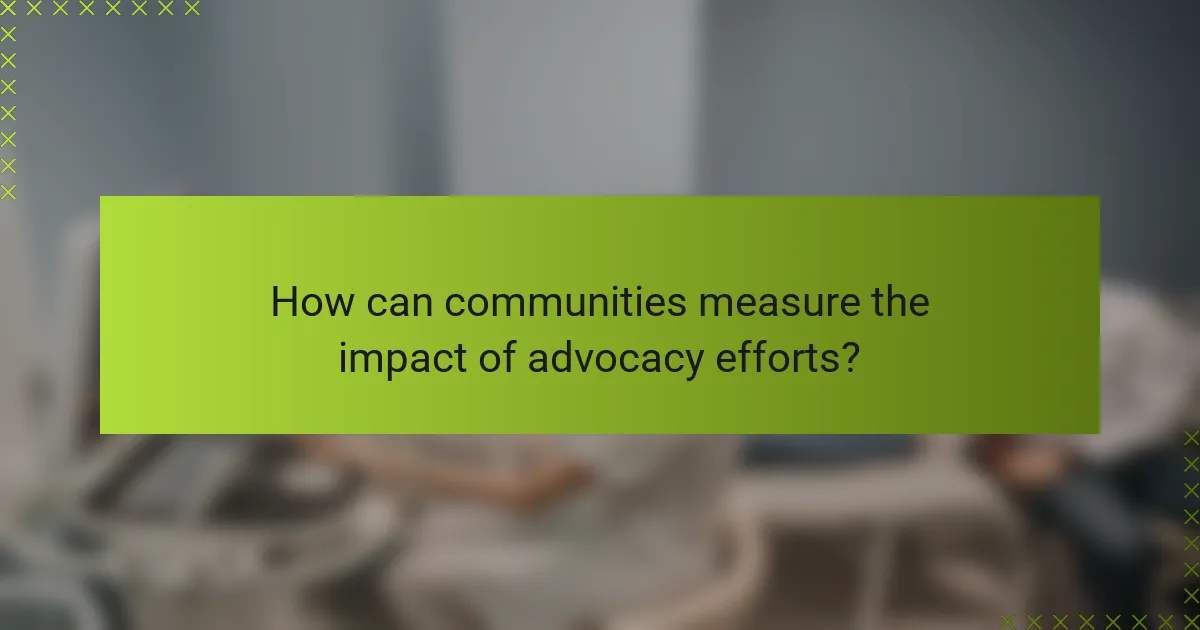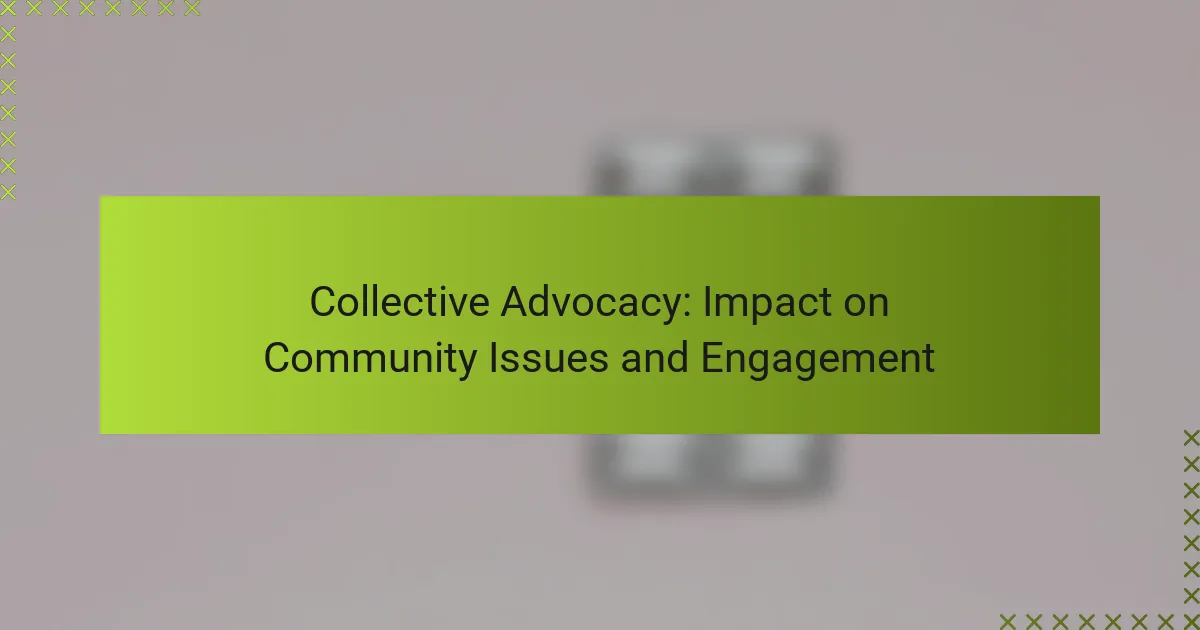Collective advocacy plays a vital role in addressing community issues by uniting individuals around shared concerns and fostering collaboration among diverse groups. By amplifying voices and enhancing engagement, it empowers communities to drive meaningful change and improve local conditions.

How does collective advocacy impact community issues in the UK?
Collective advocacy significantly influences community issues in the UK by mobilizing individuals to address shared concerns and drive change. It fosters collaboration among diverse groups, amplifying their voices and enhancing their ability to effect meaningful improvements in local conditions.
Increased awareness of local problems
Collective advocacy raises awareness of local issues by bringing them to the forefront of public discourse. When community members unite to highlight specific problems, such as housing shortages or environmental concerns, they attract media attention and engage broader audiences.
This heightened awareness can lead to increased public interest and support, encouraging local authorities and organizations to take action. For example, campaigns around air quality in urban areas have successfully prompted local governments to implement stricter regulations.
Enhanced community engagement
Through collective advocacy, community engagement is significantly enhanced as individuals feel empowered to participate in discussions and initiatives. This engagement often manifests in public meetings, workshops, and social media campaigns, where community members share their experiences and ideas.
Active participation not only strengthens community bonds but also fosters a sense of ownership over local issues. Engaged citizens are more likely to volunteer, attend local events, and contribute to solutions, creating a vibrant community spirit.
Influence on policy changes
Collective advocacy can lead to substantial policy changes at local and national levels. When groups advocate for specific issues, they can effectively lobby policymakers to reconsider existing regulations or introduce new legislation that addresses community needs.
For instance, advocacy efforts focused on mental health services have led to increased funding and improved access to care in various regions of the UK. By presenting compelling evidence and community testimonials, advocates can sway decision-makers to prioritize these issues.
Strengthened community networks
Collective advocacy fosters the development of strong community networks that facilitate collaboration and resource sharing. These networks often include local organizations, activists, and residents who work together towards common goals.
As these connections deepen, they create a support system that can mobilize quickly in response to emerging issues. For example, a network formed around food insecurity can coordinate food drives and educational programs, effectively addressing the problem through collective effort.
Empowerment of marginalized voices
Collective advocacy plays a crucial role in empowering marginalized voices within communities. By uniting individuals who may feel isolated or unheard, advocacy groups provide a platform for these voices to be amplified and recognized.
This empowerment can lead to greater representation in decision-making processes and ensure that the needs of all community members are considered. Initiatives that focus on the rights of minority groups or low-income families exemplify how collective advocacy can drive social justice and equity.

What are effective strategies for collective advocacy?
Effective strategies for collective advocacy include building strong coalitions, leveraging social media, organizing community events, and engaging with local government representatives. These approaches enhance community involvement and amplify the impact of advocacy efforts.
Building coalitions with local organizations
Building coalitions with local organizations is crucial for collective advocacy. Collaborating with established groups can provide access to resources, networks, and expertise that strengthen advocacy initiatives.
Identify organizations that share similar goals and values. Reach out to them to discuss potential partnerships, and consider forming a coalition that includes diverse stakeholders to broaden your reach and influence.
Utilizing social media platforms
Social media platforms are powerful tools for collective advocacy, allowing for rapid information dissemination and community engagement. Use platforms like Facebook, Twitter, and Instagram to share updates, mobilize supporters, and raise awareness about specific issues.
Develop a content strategy that includes regular posts, engaging visuals, and calls to action. Monitor engagement metrics to understand what resonates with your audience and adjust your approach accordingly.
Organizing community events and forums
Organizing community events and forums fosters dialogue and encourages participation in advocacy efforts. These gatherings can take various forms, such as workshops, town hall meetings, or informational sessions, and serve as platforms for sharing ideas and concerns.
Plan events that are accessible to all community members, considering factors like location, timing, and language. Promote these events through local channels to maximize attendance and impact.
Engaging with local government representatives
Engaging with local government representatives is essential for effective advocacy. Building relationships with elected officials can help ensure that community concerns are heard and addressed in policy discussions.
Schedule meetings with representatives to discuss specific issues and present data or testimonials that highlight community needs. Follow up with them regularly to maintain the relationship and keep advocacy efforts on their radar.

What role do membership organizations play in advocacy?
Membership organizations are crucial in advocacy as they unite individuals around common goals, amplifying their voices on community issues. These organizations provide essential support, resources, and a structured approach to collective action, enabling members to influence policy and drive change effectively.
Providing resources and training
Membership organizations equip their members with valuable resources and training to enhance their advocacy skills. This can include workshops, webinars, and access to toolkits that cover effective communication strategies, policy analysis, and grassroots mobilization techniques.
For instance, organizations might offer training sessions on how to engage with local government officials or how to conduct effective community outreach. Such training helps members feel more confident and prepared to advocate for their causes.
Facilitating networking opportunities
Networking is a key function of membership organizations, allowing members to connect with like-minded individuals and stakeholders. These connections can lead to collaborations, sharing of best practices, and building coalitions that strengthen advocacy efforts.
Organizations often host events, such as conferences or local meet-ups, where members can exchange ideas and strategies. These gatherings foster a sense of community and solidarity, which can be vital for sustaining long-term advocacy initiatives.
Offering platforms for collective action
Membership organizations provide platforms for collective action, enabling members to mobilize around specific issues effectively. This can include organizing campaigns, petitions, or public demonstrations that draw attention to community concerns.
For example, an organization might coordinate a campaign to address local environmental issues, allowing members to participate in rallies or submit joint letters to policymakers. By leveraging the collective power of their membership, organizations can significantly increase their impact on public policy and community engagement.

How can communities measure the impact of advocacy efforts?
Communities can measure the impact of advocacy efforts by evaluating changes in policies, gathering feedback through surveys, and analyzing participation rates in various initiatives. These methods provide tangible insights into how advocacy influences community issues and engagement.
Tracking policy changes and outcomes
Tracking policy changes involves monitoring specific legislation or regulations that advocacy efforts aim to influence. Communities should document the timeline of proposed changes, the stakeholders involved, and the outcomes achieved. For example, if an advocacy group successfully lobbied for improved local health services, tracking the implementation and usage of these services can illustrate the impact.
Consider creating a policy impact report that outlines key changes, including quantitative data such as funding amounts or service utilization rates. This report can serve as a valuable tool for future advocacy efforts and community awareness.
Conducting community surveys
Community surveys are an effective way to gather direct feedback from residents about the perceived impact of advocacy initiatives. Surveys can include questions about awareness of advocacy efforts, perceived changes in community issues, and overall satisfaction with services or policies. Aim for a diverse sample to ensure representative feedback.
Utilizing online survey tools can streamline the process, allowing for quick data collection and analysis. Regularly conducting surveys, perhaps annually, can help track changes in community sentiment over time and inform future advocacy strategies.
Analyzing participation rates in initiatives
Participation rates in community initiatives can indicate the effectiveness of advocacy efforts. By measuring attendance at events, engagement in programs, or involvement in campaigns, communities can assess how well advocacy resonates with residents. For instance, a significant increase in attendance at town hall meetings may suggest heightened community interest in advocacy issues.
To analyze participation effectively, consider setting benchmarks based on previous events or similar initiatives. This comparison can help identify trends and areas for improvement, ensuring that future advocacy efforts are more targeted and impactful.

What are the challenges faced in collective advocacy?
Collective advocacy often encounters several challenges, including coordination among diverse groups, resource limitations, and potential conflicts of interest. These obstacles can hinder the effectiveness of advocacy efforts and dilute the impact on community issues.
Coordination among diverse groups
One of the primary challenges in collective advocacy is ensuring effective coordination among various stakeholders. Different organizations may have distinct goals, communication styles, and decision-making processes, which can lead to misunderstandings and inefficiencies. Establishing clear roles and responsibilities can help mitigate these issues.
Regular meetings and collaborative platforms can enhance communication and foster a unified approach. Utilizing tools like shared calendars and project management software can streamline coordination efforts and keep all parties aligned.
Resource limitations
Resource limitations, including funding, personnel, and time, pose significant challenges to collective advocacy. Many organizations operate on tight budgets, which can restrict their ability to engage in extensive outreach or mobilization efforts. It is essential to identify and leverage available resources effectively.
Building partnerships with local businesses or seeking grants can provide additional support. Additionally, prioritizing initiatives based on potential impact can help organizations allocate their limited resources more efficiently.
Potential conflicts of interest
Conflicts of interest can arise when different groups within a collective advocacy effort have competing priorities or agendas. These conflicts can undermine trust and collaboration, making it difficult to present a united front. Open dialogue and transparency are crucial in addressing these issues.
Establishing a common mission statement and shared objectives can help align interests. Regularly revisiting these goals ensures that all parties remain focused on the collective purpose, minimizing the risk of conflicts derailing advocacy efforts.
